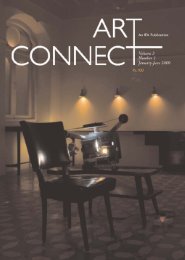Annual Report 2005-2006 - India Foundation for the Arts
Annual Report 2005-2006 - India Foundation for the Arts
Annual Report 2005-2006 - India Foundation for the Arts
You also want an ePaper? Increase the reach of your titles
YUMPU automatically turns print PDFs into web optimized ePapers that Google loves.
EXTENDING ARTS PRACTICEGroundbreaking achievements in <strong>the</strong> artsoften occur unexpectedly. Amrita Sher-Gil’spaintings, Salman Rushdie’s novels or UdayShankar’s vision of modern dance, were not bornin a vacuum but nei<strong>the</strong>r were <strong>the</strong>y <strong>the</strong> result ofconscious nurturing on anyone’s part. So while itis difficult to anticipate radical ideas in <strong>the</strong> arts, itis entirely possible to encourage <strong>the</strong> developmentof a milieu that is hospitable to such ideas.This is <strong>the</strong> intention behind our Extending<strong>Arts</strong> Practice programme. It was launched in July<strong>2005</strong> to support <strong>the</strong> innovative, <strong>the</strong> untried and<strong>the</strong> fresh in <strong>the</strong> practice of <strong>the</strong> arts. At <strong>the</strong> sametime, we do not want to make a fetish of <strong>the</strong> new:artists may be searching <strong>for</strong> ano<strong>the</strong>r direction <strong>for</strong><strong>the</strong>ir art even if <strong>the</strong>y are not seeking to produceself-professedly experimental work. In a culturethat is not generally encouraging of <strong>the</strong> exploratoryand <strong>the</strong> open-ended, our primary aim is to giveartists <strong>the</strong> confidence to try out new ideas and look<strong>for</strong> fresh ways in which to express <strong>the</strong>mselves.The four grants we have made so far allinvolve a kind of creative re-ordering of <strong>the</strong>prevalent terms of practice in different fields.Equally <strong>the</strong> artists we have supported wish toconnect <strong>the</strong>ir practice with specific cultural historiesor with aspects of contemporary society.The variety evident even in this small list pointsto <strong>the</strong> range of viewpoints and approaches thatthis programme can accommodate.At one end of this spectrum, we have amedia artist like Ashok Sukumaran whose artworkschallenge our unquestioning use of technologyin a culture of passive consumption,while also extending <strong>the</strong> field of media art itself.At <strong>the</strong> o<strong>the</strong>r end is <strong>the</strong> filmmaker KamalSwaroop, who too is extending our understandingof filmmaking by engaging with students offilm and related disciplines. In this way he ishighlighting issues not just relevant to filmmaking(and its <strong>for</strong>gotten connection with literature,photography and painting), but also toarts education.In time we intend to organise meetings andseminars on <strong>the</strong>mes relevant to <strong>the</strong> programme––like interdisciplinarity in <strong>the</strong> arts or <strong>the</strong> valueof artistic innovation. These would have <strong>the</strong>twin functions of alerting us to interesting workbeing done in <strong>the</strong> arts, while helping to stimulatediscussion on approaches to arts practicethat we feel ought to have greater currency.GRANTSKamal Swaroop, MumbaiRs 2,27,500 over three monthsTowards identifying partner institutions,developing course books and film study capsules,and fixing a time schedule <strong>for</strong> a series ofworkshops to be conducted <strong>for</strong> students of film,design and creative writing. The eventual workshopswill lead to <strong>the</strong> creation of a story-boardon <strong>the</strong> life of <strong>the</strong> pioneering filmmaker,Dadasaheb Phalke. By bringing toge<strong>the</strong>r studentsof <strong>the</strong>se various disciplines, <strong>the</strong> workshopswill explore ‘<strong>the</strong> industrial mode of production’in cinema––something which Phalke exemplifiedand which <strong>the</strong> current specialisation in <strong>the</strong>arts no longer allows <strong>for</strong>.Bodhaditya Bandopadhyay, Kolkata3From Kamal Swaroop’s manuscript, The Life and Times ofDadasaheb Phalke. See also pages 5 and 20-24.










